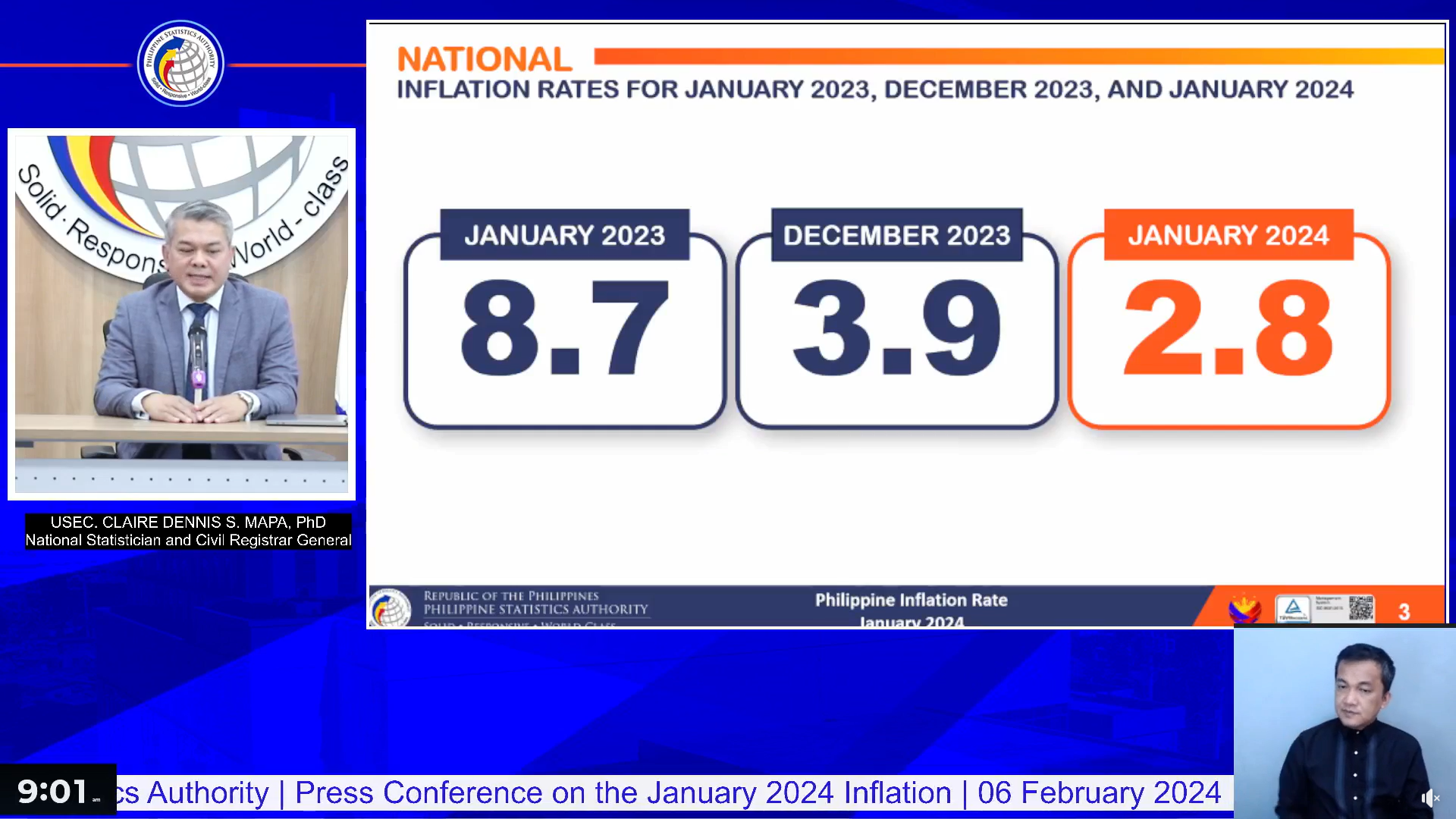
By Brian Jules Campued
The headline inflation in the country remained on a downtrend as it further dipped to 2.8% in January 2024, which is significantly slower than the 8.7% recorded in January 2023, the Philippine Statistics Authority (PSA) said Tuesday.
In a press briefing, National Statistician and PSA Usec. Claire Dennis Mapa reported that the inflation rate slowed down from the 3.9% in December 2023.
“This is the lowest inflation rate since the 2.3% inflation rate recorded in October 2020,” Mapa noted.
Meanwhile, this January inflation was within the 2.8% to 3.6% projection of the Bangko Sentral ng Pilipinas (BSP).
“This inflation outturn is consistent with the BSP expectations that inflation will likely moderate in Q1 (Quarter 1) 2024 due largely to negative base effects and some easing of supply constraints affecting key commodities,” the BSP said in a statement.
However, the Central Bank also advised the public that inflation could temporarily accelerate in the second quarter following the impacts of the El Niño phenomenon and positive base effects.
Factors that may contribute to upside pressure on inflation are higher transport charges, electricity rate hikes, increased oil prices, and higher food prices due to El Niño conditions.
“Meanwhile, the impact of a relatively weak global recovery and the government measures to mitigate the effects of El Niño could ease some price pressures,” the BSP added.
The National Economic and Development Authority (NEDA) also assured the public that it will monitor food supply and prices as the El Niño phenomenon spreads across more areas in the country.
NEDA Secretary Arsenio Balisacan said that with El Niño lingering until May, “we introduce stop-gap measures, as necessary, such as allowing further imports on key commodities until our supply stabilizes at prices affordable to consumers while ensuring remunerative prices for local producers.”
The Department of Social Welfare and Development, for its part, will expand its National Food Stamp program to cover about 300,000 households in 2024 to assist the most vulnerable families during the El Niño season.
Budget Secretary Amenah Pangandaman welcomed the news and remarked that the administration is “off to a very good start” towards high and sustained growth.
“This shows that our economic policies are taking effect in spite of global headwinds and climate change, and assures us that we are on track with our Agenda for Prosperity and in meeting our goals for Bagong Pilipinas,” Pangandaman said in a statement.
Lower inflation rates across the board
Mapa also reported that the main sources of deceleration were the gradual increase in prices of food and non-alcoholic beverages (from 5.4% in December to 3.5% in January) as well as the slower annual increment of housing, water, gas and other fuels (from 1.5% in December to 0.7% in January).
Out of the 12 commodity groups, nine showed slower and lower annual increments including alcoholic beverages and tobacco, clothing and footwear, furnishings, household equipment and routine household maintenance, among others.
Further, both transport and financial services exhibited negative inflation rates of 0.3% and 0.6% from 0.4% and zero percent in December 2023, respectively. On the other hand, education services logged a higher increment of 3.8% from 3.5% in the previous month.
Mapa also said the inflation rate in the National Capital Region (NCR) and other provinces likewise fell to 2.8% this month.
“All regions outside NCR recorded slower inflation rates during the month relative to their respective December 2023 inflation rates,” the state statistician remarked.
Ilocos Region and Cagayan Valley both recorded the lowest inflation rate at 1.5% while Davao Region had the highest at 4.4%.
Core inflation, which excludes certain food and energy items also eased to 3.8% in January from 4.4% in December.
The inflation on the bottom 30% income households also settled with 3.6% from 5.0% in the previous month.
Rice Inflation
Food inflation also eased to 3.3% in December 2023 from 5.5% in the previous month, PSA data showed.
However, rice inflation rose to 22.6% from 19.6% in December. The last highest recorded rice inflation was in March 2009 when it hit 22.9%.
Average prices of different rice classes for January monitored by the PSA: about P49.65 per kilogram (kg) of regular-milled rice, P54.91/kg of well-milled rice, and P63.90/kg of special rice. All prices increased from December’s registered average for the respective variants of rice.
Mapa attributed this increase in rice inflation to higher rice prices in the world market and the so-called “base effect” or the lower rice inflation rate recorded from January to July 2023 which means there is a lower reference point for this year’s data.
“Kung titingnan natin ang time series ng rice inflation in 2023, ito ay mababa mula January hanggang July…may mababang base ang pinanggalingan ng presyo ng bigas so ang aming calculation ay patuloy itong tataas in terms of inflation rate simply because the base is relatively low in 2023,” he explained.
Projection
While a number of items in the Consumer Price Index showed negative inflation or deceleration, Mapa noted that threats like the increase in prices of rice can affect the inflation rate in the succeeding months.
“And if there are movements in other commodity items [combined with rice inflation], that could be the source of threat sa mababang inflation rate,” Mapa stressed.
“But the overall direction is that it’s going down.” – avds
